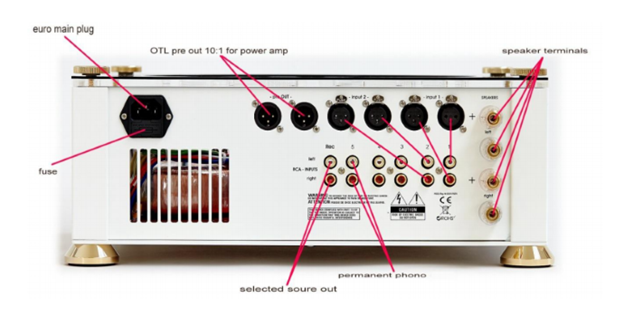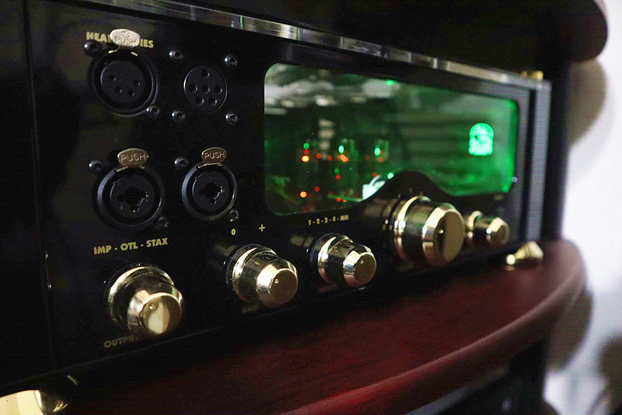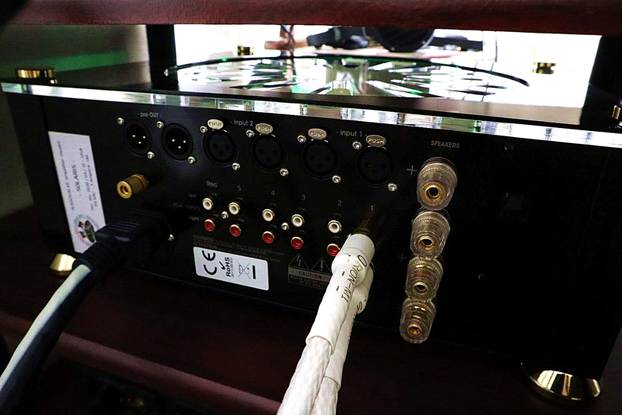Intro
Audiovalve has been a long-time member of the headphone community. I have tried Audiovalve rkv back to the days when I just built up this hobby. It was a great honor to meet with Mr. Becker – the man behind Audiovalve—during Canjam NYC and had a very nice conversation with him. To be honest, I wasn’t intended to buy the Solaris initially, because I have owned Cayin HA300, and I love it. After about 20 mins on spot listening, I decided to buy the Solaris, it is simply amazing in terms of sound quality and versatility. I will introduce more of the details in this review!
(Note: This review unit selected AMP only trim with the gold exterior, you can add DAC to have the full setup.)
Build Quality
The overall build quality of Solaris is outstanding. The exterior looks concise and classic. On the left side of the front panel, there are 4 headphones jacks—two single end 6.35mm which can also be used as dual 3-pin connectors, one 4-pin balanced jack, one 6-pin STAX jack which is capable for electrostatic headphones like STAXs and VOCE.
Under the headphone jacks, there are 5 knob switches (from left to the right): Output Mode, Gain, Input channel, Volume, and Balance (left and right channel). All these switches are very smooth and durable. On the backend, Solaris provides a total of 5 RCA input channels, 2 XLR balanced channels, 2 speaker output channels, 1 pre-out channel. Again, the build quality of these jacks is great, with no loose parts and very smooth.
Features & Specs
For details of features and specs, please refer to Solaris online user manual:
http://www.audiovalve.info/solaris/2015 solaris eng.pdf as well as page 4 of headfonia.com’s review:
https://www.headfonia.com/review-audiovalve-solaris/4/.
Sound Impression
Just like the name suggests, Solaris is like the sun—warm, powerful, and full of energy. I completely fell in love with this amp the first time I plug my headphones into the amp. I have tested Abyss 1266TC, Hifiman Susvara, Final D8000 Pro, Meze Empyrean, Focal Utopia, Fostex TH900, Beyerdynamic T1(unfortunately I do not have electrostatic headphones in my collection). All these headphones sound very satisfying with no background noise at all even with high sensitivity headphones like Utopia and TH900. It is very impressive because high output tube amplifiers usually have humming issues, but there is no such noise with Solaris, none.
Solaris has a very balanced sound, with a slight emphasis in bass and mid. The overall sound signature is very imposing and well structured. The soundstage is in an excellent 3-dimensional figure, however not very tall compare to another headphone amp I have—Cayin HA300.
As a tube amplifier, Solaris provided outstanding resolutions, details, dynamics, and speed. In these categories, Solaris can beat most tube amps I have heard including the more expensive WA33(standard version). I was quite surprised because initially, I think ECL85 tubes are not famous for their resolution and dynamic, etc. Apparently, Mr. Becker and his team paid lots of effort in designing and tuning this outstanding amplifier.
I had used RKV3 for a while many years ago, in my opinion, Solaris sounds a lot smoother than RKV3. Solaris is more balanced and has better resolution and details. Although I found Solaris is still a little edgy in the top end, in my opinion, it is completely tolerable.
For music genres, I think Solaris is good for all genres. I find Solaris is extremely good with classic (especially large-scale symphony), metal, rock, funk, POP, and EDM. But Solaris is not my first choice for acoustic or piano solos.
Abyss 1266TC/Hifiman Susvara
I put these 2 headphones in one category because both of them are extremely power-consuming planars. Thus, I mainly used OTL mode with mid or high gain with these headphones. Solaris has up to 12W per channel output power which is sufficient for both headphones (from my experience, an amp with 5-6w per channel can power up 1266 to an acceptable level, while Susvara requires at least 8-10W, however, no one knows exactly what is the optimal output power for these 2 beasts).
1266TC is my favorite headphones with Solaris. Solaris has enough power to drive 1266TC and reveal all its potential. The overall presentation of this combo is leaner and balanced. I can get a deeper bass from this combo than any other I have tried. More importantly, I have heard more bottom end details than ever before. The mid is also very full and rich, especially the lower mid. It is very enjoyable to listen to male vocals using this combo. The treble extends very far and still being very nature without too many artificial flavors.
I have tried one of my favorite smooth jazz albums
Live from the Inside by Brian Culbertson which requires great dynamic, speed, image and control, this combo has interpreted this album perfectly. The trumpet is full of energy in the treble region, and piano notes, bass slaps, and drumbeats are staying super clean no matter fast or slow.
Another beast Susvara is even harder to drive. I have tried many AMPs to power up Susvara including some power amp like First Watt J2 and Byston B135-SST2. So far, the best AMP I found for Susvara is still Cayin HA300 with Psvane ACME 300B power tubes and Ken-Rad 6s7n vt-231 driver tubes.
With Solaris, Susvara is able to provide outstanding bass extension, it can reach very deep when required and I found it reaches noticeably deeper than HA300. The mid is full and forward, however, compare to HA300 Solaris sacrifices a touch of smoothness for a cleaner and fuller image. Similarly, with Solaris Susvara’s treble sounds very energetic and vivid but again the smoothness was sacrificed.
Personally, I prefer 1266TC with Solaris and Susvara with HA300. Solaris can fully elevate all the strength of 1266TC, unbounded soundstage, clear and accurate image and positioning, deep and solid bass, spectacular dynamic… Listening to the metal songs with this combo, I feel like I am standing right in front of the stage of a metal live. That’s being said, both Solaris and 1266TC are terrific in performing magnificent scenes. While Susvara is another story, Solaris makes Susvara sound full and rich but also a bit too serious and aggressive. Solaris uses a straightforward way to interpret music, it is completely fine with Abyss but not with Susvara. Susvara doesn’t have the boldness and momentum that Abyss has, but it interprets music beautifully and euphemistically. Solaris is considerably a good match with Susvara in terms of the degree of completion. However, I do prefer the euphonic sound and the ultra-smoothness that HA300 offered to Susvara.
Final D8000 Pro/ Meze Empyrean
D8000 Pro and Empyrean are not hard to drive compare to 1266TC and Susvara. I tend to use impedance mode (IMP) and low gain more with them, but I do find the OTL mode also sounds pretty good with them. With the IMP mode, I find both D8000 Pro and Empyrean sound more natural; with the OTL mode, D8000 Pro and Empyrean sound more forward and energetic.
D8000 Pro is my favorite headphones for Metalcore/Progressive Metal/Funk/EDM. With Solaris, D8000 Pro’s bass sounds fast, tight, and punchy. This type of “shotgun” bass is ideal for high speed, rhythmic music genres I mentioned above. You will get a forward, full, rich mid with a touch of warmth. The vocals and guitars have very good textures. The treble is reasonably smooth, the brightness is right to the point, very balanced to my taste. The treble extends very far with a good amount of sparkles. The only downside I could find is the vocal size is a bit too big, which sometimes gives me some pressure. But overall, I truly love this combination. I believe, every metal lover will love this combination too.
Empyrean is known as the vocal master, both male and female vocal are perfectly presented. But as many enthusiasts (including me) described, the bass from Empyrean is too much. Solaris has a very good bass control; the bass is not as loose and soft as it was on some other AMPs that I've tried, but I still think it is too much not Solaris's problem, the headphone's. The mid and vocal is heavenly good, it is easily the best vocal I have ever heard. It is full of emotion and details, the voice has great size and distance, it is upfront but not "in your face". Also, benefits from the excellent treble extension of Solaris, the Empyrean's treble sounds not only smooth but also vivid.
Focal Utopia/Fostex TH900
Both Focal Utopia and Fostex TH900 are ultra-sensitive dynamic headphones. Naturally, the IMP mode is the right way to go. I was worried about the hissing issue that happened on my other amps. But the background of Solaris is deadly quiet, I don’t catch any hissing problem with Utopia or TH900.
I paired Utopia with Dana Lazuli Reference cable which polished the treble of Utopia and largely eliminated the "metallic tones" at the top end. Solaris added more warmth to the Utopia makes Utopia sound smoother, fuller, thicker, and a lot more natural. There are two problems I found with this combo, one is that the vocal is too upfront, the other is that the mid-bass is a little overwhelming. They are not big issues, just not in my personal preference. The outstanding dynamic, incredible amount of detail is all presented clearly. The soundstage is kind of intimate horizontally, but it is very tall vertically. Overall, I think Solaris has good synergy with Utopia.
TH900 is a classic V shape headphone, the unique signature of TH900 makes it very picky about AMPs. Solaris is a very good match with TH900. Solaris can add some extra warmth to the TH900. The mid and treble sounds smooth and refined. Although Solaris is not able to fill up the recessed mid of TH900, it makes the mid and vocal much more enjoyable than other AMPs I have tried. Also, Solaris has a very nice bass control, you will get a deep, fast, and tight bass and the bass does not bleed into mid-section.
Beyerdynamic T1
Beyerdynamic T1 is 600 Ω high impedance dynamic headphones. I used IMP mode with high gain for testing. T1 sounds great on Solaris. Solaris adds more flavors to T1, especially at the top end. My previous impression with T1 was quite contradictory. I think it has a very nice sound quality technically but flavorless musically. Thus, I used T1 more with some calm or serious tracks. With Solaris, T1 sounds more colorful and harmonically beautiful, sounds more approachable.
Summary
Unfortunately, I was not able to test electrostatics headphones for this review, but I can tell Solaris is a great all-rounder headphones AMP with both dynamic and planar headphones at least. In terms of sound quality, Solaris has a full and balanced signature with a touch of extra warmth and some classic "tube flavor". Bass is rich, weighted and powerful, mid and treble are smooth and sweet, plus there are some nicely tuned sparkles in the treble. Simply put, Solaris sounds so beautiful in a natural way. Solaris's technical performance is also outstanding. Details, micro-dynamic, and the expansive soundstage are organically put together.
The only limit I have found on Solaris is that the way of Solaris interpreting music may not be appreciated by all headphones and all genres. From my experience, I found Solaris doesn't fit well with soft/gentle genres or headphones that have a soft/gentle signature. Other than that, Solaris is so close to perfect.
Bonus Comparison
It is a little bit hard to write a comparison review on headphone AMPs because there will be so many headphones involved. In this review, I will briefly compare Cayin HA300 and Solaris.
The sound signature differences between HA300 and Solaris are like Yin & Yang. HA300 has a classic 300B tubes' house sound. It has a very beautiful mid-range tonality, very rich harmonic, and holographic presentation. However, the soundstage is kind of intimate, the bass is soft and not as impactful as Solaris. Solaris on the other hand has a powerful and impactful bass foundation. The mid and treble are more forward and energetic. The soundstage is very expansive, and the dynamic changes are more dramatic. But compare to HA300, Solaris lacks a sense of artistry. It is not as smooth as HA300 in treble and mid. Therefore, I found HA300 has a better performance in almost all vocal and strings tracks, where Solaris is better for classic and rock/metal genres. Both AMPs are very appealing to my ears, but for different genres and headphones, I will choose different AMPs. As a summary, I have classified my personal preferences of these two AMPs with different headphones and genres:
| Amplifiers | Headphones | Genres |
| Audiovalve Solaris | Abyss 1266TC, Final D8000, Beyerdynamic T1 | Metal and its subgenres, Classic, Rock, Funk, EDM, Hip-hop, Western POP |
| Cayin HA300 | Hifiman Susvara, Focal Utopia, Fostex TH900 | Vocal, Acoustic, String and Piano Solo, Blues and Soul, Asian POP. |







